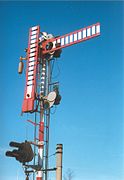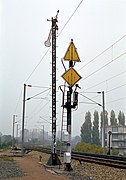Wing signal

Wing signals , in Switzerland semaphore ( singular : the semaphore ), out of date also called arm signals , are shape signals with one, two or rarely three signal wings that are rotatably arranged one above the other on the signal mast.
In the meantime, the shape signals have largely been replaced by light signals , but are still used at stations that have not yet been modernized.
history
The wing signal was a takeover of similar instruments from seafaring. In the early 1840s, John James Stevens received a patent for the use of wing signals in railroad traffic. The first signal constructed in this way was installed by Charles Hutton Gregory in New Cross (London) on the London and Croydon Railway in 1842/43 , and over the next 30 years this form prevailed over other mechanical signal systems. The first of these signals were installed on the roof of the signal boxes. It was not until later that cables were developed in order to be able to operate signals that were distant from the signal box.
technology

Wing signals have one or more arms (wings) that can be swiveled up or down into different positions. Arrangements of the wings made by pivoting at certain angles represent different signal terms. A single, horizontally lying wing usually corresponds to the strongest restriction that the signal can represent, stop . Wings pointing upwards or downwards weaken this or cancel it out entirely. In the current signal system of DB AG, for example, a single wing pointing 45 ° to the top right means the signal aspect Hp 1 run .
application
In the German-speaking countries, wing signals are mostly used as the main signals , but in Bavaria they were also used as distant signals . The Belgian, Dutch and Danish railways also use wing signals as distant signals. On the English railways, the so-called distand signal has the meaning of an advance signal . It is a wing advance signal that differs from the entry and exit signals only in that its wing has a triangular cutout at the free end.
photos
Red main and yellow distant signal , England
See also
literature
- Helge Holz: Wing Clinic. Visit to the signaling plant in Braunschweig . In: railway magazine . No. 1/2013 . Alba publication, January 2013, ISSN 0342-1902 , p. 99-101 .
- Lionel Thomas Caswell Rolt : Red for Danger . Edition: London 1978.
Web links
Individual evidence
- ^ Hans G. Wägli: Lever, bolt and signals . Diplory Verlag, Grafenried 2018, ISBN 978-3-03306410-2 , p. 30 .
- ^ Rudolf W. Butz: Signals of the Swiss Railways . Orell Füssli Verlag, Zurich 1972, p. 32-35 .
- ↑ Victor of Röll : Armsignal. In the Enzyklopädie des Eisenbahnwesens, Volume 1. Berlin, Vienna 1912, p. 272. Online at zeno.org.
- ↑ Lexicon of the Railway. 5th edition. Transpress VEB Verlag, Berlin 1978, p. 281 (keyword form main signal (Hf) )
- ↑ Rolt, p. 41.
- ↑ Erhard Born, Alfred Herold, Walter Trüb, (Ed.): Hobby Lexicon Railway. Rowohlt Taschenbuch, Reinbek near Hamburg, 1980, ISBN 3-499-16262-8 . P. 109 (Keyword: wing signal. )
-
^ Victor von Röll: distant signal. In the Enzyklopädie des Eisenbahnwesens, Volume 10. Berlin, Vienna 1923, pp. 224-231. Online at zeno.org.
These sections are largely based on the entry in the encyclopedia of railways by Victor von Röll († 1922), that in the European Union, Switzerland and all other countries with a legal protection period of 70 years after the death of the author, as well as for the United States is in the public domain.




